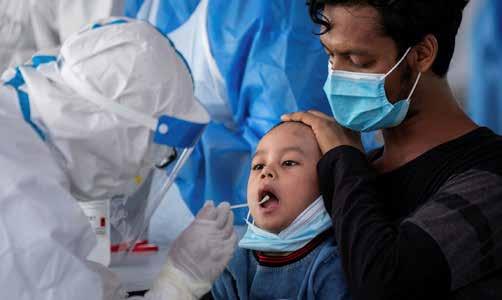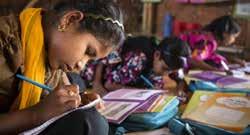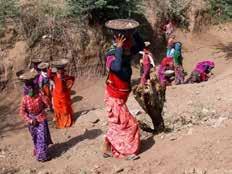
17 minute read
Newscan
120 million children in South Asia could be pushed into poverty: UNICEF
NEW DELHI: Making clear the most serious effects of COVID-19, a report by the United Nations Children’s Fund has revealed that the pandemic could push an additional 120 million children in South Asia into poverty. The South Asian region, which is home to nearly a quarter of the world’s population, has seen a rapid increase in the number of COVID-19 cases in various countries in the region. The report titled, “Lives upended: How COVID-19 threatens the futures of 600 million South Asian children,” noted that children are at a lower risk of being infected by the virus due to their strong immunity, they are probably the ones that are going to be most affected by the economic and social effects of the pandemic.
Advertisement
In eight countries that have been included in the study, Afghanistan, Pakistan, India, Nepal, Bhutan, Bangladesh, Maldives, and Sri Lanka, an estimated 340 million children already live in ‘multi-dimensional poverty’. This means that 240 million children residing in these eight countries experience poverty in various sectors of life – poor health, lack of education, poor sanitation, poor quality
of work and sometimes even forced child labour.
The report quoted a research by the Johns Hopkins Bloomberg School of Public Health, according to which in the worst situation, there could be additional deaths of as many as 881,000 children aged 5 or under and that of 36,000 mothers over the next twelve months in South Asia. The maximum number of deaths would happen in India and Pakistan, although Bangladesh and Afghanistan could also see considerable levels of additional mortality. According to the report, the pandemic may push an additional 120 million children across the poverty line within the next six months. It pointed out that India and Nepal, among other countries face a particular problem where the communities need to be assured that hundreds of schools being utilized as quarantine centres are safely disinfected before children are permitted to go back to class.
Jean Gough, Regional Director (South Asia), UNICEF, said that the side effects of the pandemic across South Asia have been damaging the children in numerous ways. This not only includes the economic and social effects of the pandemic but also the measures taken by the government to stop it.
He went on to add, “But the longerterm impact of the economic crisis on children will be on a different scale entirely. Without urgent action now, COVID-19 could destroy the hopes and futures of an entire generation.” Reduced access to schools, lack of nutrition, a pause in vaccination and other health awareness programs and risk of sexual, mental and physical abuse during the lockdown are some of the problems that children in South Asia stand to face in the coming months, said the report.
UNICEF cited seven outbreaks of measles or 250 cases in Nepal during its lockdown and a 55% drop in the number of routine vaccinations given to Bangladeshi children in April, as compared to February.
According to the report, immunization, nutrition and other vital health services have been severely disrupted, potentially threatening the lives of young children and mothers. And with the closure of schools, the report estimates that more than 430 million children have been shut out of their classrooms.
In many cases, remote learning has taken the place of actual classrooms, but the unavailability of internet connection or electricity in rural areas meanshas limited access in many places. The report further noted that while the pandemic has had a devastating effect on the economies of all eight countries under scrutiny, their governments have done little or nothing to handle the situation. Those countries that have managed to extend social security schemes and introduce emergency measures have not been able to do so efficiently and so that effects of these measures go to waste.

ILLINOIS: As of now, there are more than 10 million cases COVID-19 cases being reported from around the world, out of which almost 6 lakh confirmed cases have been registered in India. While the elderlies and those with a weak immune system are at a high risk of severe infections and deaths from the highly infectious coronavirus disease, there are certain reports that suggest less severe symptoms in children from the contagion. However, one such study conducted in the United States of America has found a multisystem inflammatory condition has emerged in children in association with prior exposure or infection to SARS-CoV-2 which can cause life-threatening complications in children between the age group of 0 to 19 years.
A new case series published in ‘Radiology’, a scientific journal, examines the spectrum of imaging findings in children with the postCOVID-19 inflammatory condition known as Multisystem Inflammatory Syndrome in Children (MIS-C). The array of findings includes airway inflammation and rapid development of pulmonary edema, coronary artery aneurysms and extensive intraabdominal inflammatory changes. In April 2020, Evelina London Children’s Hospital in London, U.K., witnessed a rise in the number of children suffering from a multi-system inflammatory syndrome. Various symptoms including fever, headaches, abdominal pain, rash, and conjunctivitis were found in children. Clinical features and lab findings have noticed its similarity to Kawasaki disease shock syndrome, which causes inflammation in the walls of blood vessels.
Shema Hameed, M.B.B.S., consultant pediatric radiologist, Evelina London Children’s Hospital, study’s lead author said that their hospital saw an unprecedented group of children showing MIS-C, a new hyperinflammatory syndrome related to the current COVID-19 pandemic and recognition of which led to a national alert.
For the study, researchers performed a retrospective review of clinical, laboratory and imaging findings of the first 35 children under the age of 17 who were admitted to Evelina London Children’s Hospital from April 14 to May 9, 2020, and it included 27 boys and 8 girls, with a average age of 11 years old.
In 94 per cent of the children, the most common clinical presentation was fever, abdominal pain, vomiting, and diarrhea was observed in 86 percent, rash in 37 percent and conjunctivitis in 26 percent of them.
Twenty-one children among them were found in shock and the clinical status of those 24 of 35 children (69 per cent) in the pediatric intensive care unit, of which 7 (20 percent) required mechanical ventilation and 20 (57 percent) inotropic support was severe enough to warrant supervision.
Two children required extracorporeal membrane oxygenation (ECMO) due to severe myocardial dysfunction. Lab tests revealed that all of the children had abnormal white blood cell counts.
The emerging pattern of the imaging findings indicated airway inflammation, rapidly progressive pulmonary edema, coronary artery aneurysms, and extensive abdominal inflammatory changes within the right iliac fossa in post-COVID-19 MIS-C.
The chest X-ray of all the 35 children was taken due fever, sepsis, or features of multisystem inflammation and 19 X-rays among them were found to be abnormal in which the most common finding was bronchial wall thickening. The predominant findings on chest CT were basal consolidation, or part of the lung filling with fluid, and collapsed lung with pleural effusions, or build-up of fluid in the outer membranes of the lungs. Abdominal ultrasound findings included inflammatory changes within the right iliac fossa, with mesenteric fat stranding, lymphadenopathy, and bowel wall thickening, as well as free fluid in the pelvis.
The authors of the study recognized that because of a small study population, their findings cannot be generalized so they mentioned the need for further investigations. They added that the results from the study are still important in improving knowledge to understand how COVID-19 affects children.
BRIEFS | NEWSCAN
India to get 200 urban forests soon
UN Experts urged the Indian Government to follow the Supreme Court ruling to ensure the wellbeing of more than 100 million internal migrant workers suffering hardship during the COVID-19 pandemic. As per the Supreme Court’s directive, the government has to register them, ensure them free travel by train or bus and provide them with food, shelter and water until they reach their homes. The experts also pointed out that the lack of coordination among states for transportation of migrants and most workers not being able to qualify for relief packages makes the efforts simply inadequate.
NCERT joins hands with UNICEF for safe e-learning
National Council of Educational Research and Training (NCERT) has collaborated with United Nations Children’s Fund to release a handbook, ‘Safe Online Learning in Times of Covid -19’, focusing on prevention of students from the growing menace of Cyber Bullying and its impact on them and their education. The handbook points out that education departments have made efforts to ensure continuity of learning through various digital platforms which makes them vulnerable to Cyber Bullying. The handbook also explains how to prevent and counter cyberbullying by not responding or retaliating to it. It advises students to have a strong password and security setup for various digital accounts. NEW DELHI: Prakash Javadekar, Union barren land under the Maharashtra Forest Environment Minister, announced the Department, the forest had depleted due central government’s new scheme to to many encroachments by slums and develop 200 urban forests across various builders. However, the Maharashtra cities in India. Under the ‘Nagar Van’ Forest Department collaborated with scheme, the Forest Department will be TERRE Policy, a local NGO; Tata Motors collaborating with municipal bodies, and Persistent Foundation, to convert NGOs, corporates, etc. to ensure public the land into a forest rich in biodiversity, participation in giving cities better lungs. the minister informed. The minister These forests will be constructed on the also highlighted Smriti Van’s ascent vacant land, which would be offered in becoming an urban forest rich in to the government by the urban local biodiversity. bodies, or preexisting forests would Javadekar said that village forests have be modified. been an integral part of our society for Javadekar highlighted that the Warje ages. Under the new scheme, the urban Hill urban forest will serve as a pioneer to forest would be used to fill the gap in the new forests that are to be constructed urban areas for green spaces, which can across the rest of the country. Built on act as carbon sinks. NGT asks CPCB to impose revised environment compensation for CETPs

NEW DELHI: The National Green Tribunal (NGT) has asked the Central Pollution Control Board (CPCB) to gather and submit information regarding compliance and non-compliance of effluent and sewage treatment plants (STPs) across the country. NGT has also asked the green body to evolve an environmental compensation (EC) structure for all non-complying treatment plants across India.
This comes after CPCB submitted a compliance report to the NGT in May 2020 in response to an order issued by the latter regarding pollution caused by non-complying wastewater, sewage and effluent treatment plants. According to the report, a total of 191 common effluent treatment plants (CETP) operate across India out of which, 63 do not comply with the standards set by the NGT and CPCB. Show-cause / closure notices have been issued to 22 non-complying CETPs; legal cases filed against 9 CETPs, and no action has been taken so far for the remaining 32 CETPs. A majority of the non-complying CETPs are located in Gujarat (17), followed by Rajasthan (11), Tamil Nadu (9) and Delhi (9). During the inspection, it was found that some of these CETPs were operating without any consent/license renewals. This issue of EC regime for CETPs was discussed in February and March 2020. Based on the discussions held in the committee meeting, NGT asked CPCB to prepare and finalise a revised environmental compensation regime for non-complying CETPs. The CPCB, therefore, is now in the process of revising the EC regime for CETPs.
Education of children suffers due to technological disparity: UNICEF

New York : With 1.2 billion children out of schools due to the COVID-19 pandemic, the existing learning crisis has now become even more divisive and deepening, as there are disparities in access to technology and material to continue studies. According to UNICEF data, 71 countries around the globe have less than half the population with internet access. Nearly three-quarters of governments in 127 countries are using online mediums to deliver education during this time. Robert Jenkins, Chief of Education, UNICEF, said it is very important to provide learning tools and accelerate access to the internet to support these children. Jenkins further said that a learning crisis before COVID-19 was already going on and it would only grow in severity following it. As per UNICEF’s data, in 40 of 88 countries, the children living in urban areas are found to be twice as likely to have a TV than those living in rural areas. The largest disparity can be found in Sub-Saharan Africa where only 1 in 100 homes of rural Chad have TV in comparison to 1 in 3 in cities.Governments in many countries are using television as a medium to deliver education despite the difference in TV ownership. Different approaches are being used like Television, Radio, Internet, paperbased, with the help of local service providers, offline recorded lessons being uploaded onto solar-powered tablets, video lessons through social media channels such as WhatsApp and Facebook and tablets equipped with connectivity and educational content provided to students to meet the currents demands.
MGNREGA employs over 49.5 lakh people in Rajasthan alone
JAIPUR: It is quite evident how the Covid -19 pandemic has affected every sphere of life to some extent. Due to the pandemic and the consequent lockdown in India, national unemployment rates have skyrocketed and are expected to rise even further with time. However, during this time, the central government’s flagship employment scheme – the Mahatma Gandhi National Rural Employment Guarantee Act (MGNREGA) has recorded great success this year. In Rajasthan alone, in the month of June 2020, over 49.5 lakh people were employed under MGNREGA. This marks an increase of 17 lakh people as compared to the same time last year. However, according to officials, the spike was not only because of the large number of people who have returned home. A large section of the people who got employment under MGNREGA this year are locals who lost their jobs owing to the Covid -19 lockdown. PC Kishan, Commissioner, MGNREGA Rajasthan, said that a total of 49,52,496 people in 9,983-gram panchayats across the state have been employed under the scheme. Kishan also stated that there is sufficient evidence to prove that the scheme has been a success amongst migrant workers who have returned to the state amid the lockdown. This is evident from the fact that a large proportion of the people employed under the Act also belong to the border districts of Rajasthan. A large number of people who returned from other states are now residing in these border districts.
The state government has also lauded the success of the scheme, along with several gram panchayats and experts. According to officials, Rajasthan is currently at the top in terms of employing people under MGNREGA.
ICMR recommends quick tests in containment zones
In a bid to ensure a quick diagnosis of the virus infection and, hence, quick action, the Indian Council of Medical Research (ICMR) has recommended the use of Standard Q COVID-19. The test detects antigens via nasal swab and the Council has recommended its use in containment zones as well as in medical settings. The test allows result determination in up to 30 minutes. ICMR said that people living in containment zones who have influenza-like symptoms must be checked for the virus using this test. Asymptomatic people, who have come in contact with the aforementioned, must also be checked regularly between day 5 and 10 of coming in contact with the infected.
Hydroxychloroquine ineffective in treating COVID-19: FDA
The Food and Drug Administration(FDA) on June 15 revoked emergency use of malaria drugs hydroxychloroquine and chloroquine, which was granted late March, and was backed by President Donald Trump, amid growing evidence that it was ineffective to treat coronavirus and also cited reports of heart complications and other side effects from the drug. So far, no study has been able to prove the safety and affectivity of the drugs, but a string of recent studies has made clear that it does more harm than good.
BRIEFS | NEWSCAN
Health Ministry issues new advisory for healthcare workers
In their latest advisory, the Ministry of Health and Family Welfare (MoHFW) has reduced the quarantine period for healthcare workers (HCWs) with high-risk exposure to COVID-19 from 14 days to one week. MoHFW also directed the nodal officer or head of the department to form a subcommittee to assess the level of exposure and the risk for the healthcare workers managing COVID-19 cases and further ensure that they are being provided with chemoprophylaxis under medical supervision. The Nodal Officer will also make sure that healthcare workers are using Personal Protective Equipment (PPEs) while on duty as per their risk profile.
Rajasthan caps charges of various Covid -19 testing
The Government of Rajasthan has capped the testing charges in the state’s private labs at Rs 2,200. Earlier, the charges were capped at `3,500 to `4,500. Ashok Gehlot, Chief Minister, Rajasthan, took the decision in a meeting held on Friday, June 19, to review the measures taken to fight Covid -19 in the state. In the two-hour long meeting, Gehlot also announced the decision to cap the maximum charges per bed at `2,000 and for beds with ventilator at `4,000. He said that strict action would be taken against those who violate the rules of the government regarding Covid -19 testing and treatment.
US government approves $340 million investment loan for projects in India
NEW DELHI: The Government of United States has, with the aim of uplifting underserved communities, approved loans and investment worth $340 million for Indian firms and organisations. A major proportion of these loans were part of the $1 billion in investments approved by the US International Development Finance Corporation (DFC)’s Board of Directors to advance and facilitate development in Africa, Latin America, the Indo-Pacific and other emerging markets around the world.
According to a statement by the US Embassy in India, the projects that will benefit from the loans will majorly support developing countries reeling from the impact of COVID-19.
As part of the initiative, ReNew Power has been granted a $142 million loan to construct and operate a 300 MW solar power plant in Rajasthan to advance India’s energy security. Another $50 million will be made available to Sitara Solar Energy Private Limited to build and operate a 100 MW solar power plant in Rajasthan to further enhance power supply in India. Up to $371,000 in technical assistance will also support Milk Mantra to produce and sell dairy products in eastern India. This technical assistance is intended to enhance the impact of an approved DFC loan to the project by sharing the costs of services.According to Adam Boehler, CEO, DFC, the investments made as a result of the $1 billion loan will help uplift some of the most underserved countries and economies in the world. This set of investments also marks one of the largest tranches approved by the board of directors of DFC. The projects approved under the initiative will help strengthen health systems, bolster food security and support other impactful development outcomes. Several projects expand access to financial services for women, small businesses, and other underserved groups.
Migrants to get 20% wage hike, employment benefits after BRO-Jharkhand agreement

RANCHI: The Government of Jharkhand and the Border Roads Organisation (BRO) have reached an agreement to ensure that labourers of the state get prescribed wages and healthcare, accident, travel allowance and housing benefits. According to an official statement by the state government, a total of 11,815 labourers from the Santhal Pargana region in Jharkhand will get an opportunity to work for BRO. Apart from this, they will also enjoy all employment benefits. A statement issued by the Chief Minister’s Office in Jharkhand said that the deliberations between the two organisations began when Hemant Soren, Chief Minister, Jharkhand, visited the Birsa Munda Airport to meet the first batch of migrant labourers flying back to the state from Leh on May 29. While welcoming them, he heard the grievances of the labourers and the fact that they were forced to work in unsafe conditions and were not even given minimum wages by their employers. After days of deliberation, a written agreement under the Inter-State Labour Act, 1979 and the Workmen Compensation Act, 1923 was reached. Following the agreement, the state government has permitted the BRO to engage labourers who will now get wages with a 20 per cent hike, which will be deposited in their accounts.










